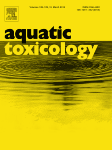An investigation of the inter-clonal variation of the interactive effects of cadmium and Microcystis aeruginosa on the reproductive performance of Daphnia magna
An investigation of the inter-clonal variation of the interactive effects of cadmium and Microcystis aeruginosa on the reproductive performance of Daphnia magna
 Stressors seldomly occur isolated in the environment. In a mixture, stressors can interact with each other. That might have profound adverse effects on the animals that live in the environment. Indeed, in mixture toxicity, one plus one does not always equals two. Imagine for instance the effect of throwing a mentos candy in coke (Youtube: MythBusters - Diet Coke and mentos). The effect of both combined is much larger than what you would expect. Such (synergistic) interactions between the metal cadmium and the cyanobacterium Microcystis are what De Coninck et al. (2013) studied in their most recent paper. Cyanobacteria are toxic blue-green algae that tend to increase in occurence due to climate change (for instance, Global Water Forum).
Stressors seldomly occur isolated in the environment. In a mixture, stressors can interact with each other. That might have profound adverse effects on the animals that live in the environment. Indeed, in mixture toxicity, one plus one does not always equals two. Imagine for instance the effect of throwing a mentos candy in coke (Youtube: MythBusters - Diet Coke and mentos). The effect of both combined is much larger than what you would expect. Such (synergistic) interactions between the metal cadmium and the cyanobacterium Microcystis are what De Coninck et al. (2013) studied in their most recent paper. Cyanobacteria are toxic blue-green algae that tend to increase in occurence due to climate change (for instance, Global Water Forum).
Scientific abstract
Interactive effects between chemical and natural stressors as well as genetically determined variation in stress tolerance among individuals may complicate risk assessment and management of chemical pollutants in natural ecosystems. Although genetic variation in tolerance to single stressors has been described extensively, genetic variation in interactive effects between two stressors has only rarely been investigated. Here, we examined the interactive effects between a chemical stressor (Cd) and a natural stressor (the cyanobacteria Microcystis aeruginosa) on the reproduction of Daphnia magna in 20 genetically different clones using a full-factorial experimental design and with the independent action model of joint stressor action as the reference theoretical framework. Across all clones, the reduction of 21-day reproduction compared to the control treatment (no Cd, no M. aeruginosa) ranged from −10% to 98% following Cd exposure alone, from 44% to 89% for Microcystis exposure alone, and from 61% to 98% after exposure to Cd + Microcystis combined. Three-way ANOVA on log-transformed reproduction data of all clones together did not detect a statistically significant Cd × Microcystis interaction term (F-test, p = 0.11), meaning that on average both stressors do not interact in inhibiting reproductive performance of D. magna. This finding contrasted expectations based on some known shared mechanisms of toxicity of Cd and Microcystis and therefore cautions against making predictions of interactive chemical + natural stressor effects from incomplete knowledge on affected biological processes and pathways. Further, still based on three-way ANOVA, we did not find statistically significant clone × Cd × Microcystis interaction when data for all clones were analyzed together (F-test, p = 0.07), suggesting no inter-clonal variation of the interactive effect between Cd and Microcystis. However, when the same data were quantitatively analyzed on a clone-by-clone scale, we found a relatively wide range of deviations between observed and IA-model-predicted reproduction in combined Cd + Microcystis treatments (both in direction and magnitude), suggesting some biological significance of inter-clonal variation of interactive effects. In one of the twenty clones this deviation was statistically significant (two-way ANOVA, F-test, p = 0.005), indicating an interactive Cd × Microcystis effect in this clone. Together, these two observations caution against the extrapolation of conclusions about mixed stressor data obtained with single clones to the level of the entire species and to the level of natural, genetically diverse populations.
Post-print full text [PDF]
Full reference
De Coninck D, Janssen C, De Schamphelaere KAC. 2013. An investigation of the inter-clonal variation of the interactive effects of cadmium and Microcystis aeruginosa on the reproductive performance of Daphnia magna. Aquatic Toxicology, 140-141:425-431. doi:10.1016/j.aquatox.2013.07.005
